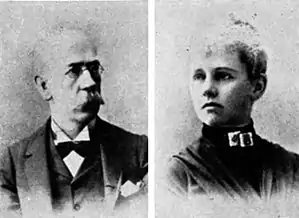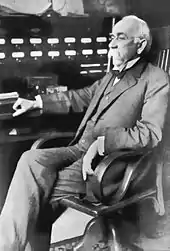George and Elizabeth Peckham
George Williams Peckham (March 23, 1845 – January 10, 1914) and Elizabeth Maria Gifford Peckham (December 19, 1854 – February 11, 1940) were a married couple who were early American teachers, taxonomists, ethologists, arachnologists, and entomologists, specializing in animal behavior and in the study of jumping spiders (family Salticidae) and wasps.

Lives and careers

George Peckham was born in Albany, New York. At age 18, he enlisted in the U.S. Army to fight in the American Civil War, reaching the rank of first lieutenant. After the war, he resumed his studies, obtaining a law degree from Albany Law School in 1867.[1] After graduation, George worked at the law office of James T. Brown of Milwaukee.[1] Not caring for the law, however, he became a student in the medical college of the University of Michigan, earning his M.D. in 1872.[1] Rather than practice medicine, however, he chose to teach biology at East Division High School of Milwaukee, Wisconsin. In 1880, he organized the first American biological laboratory program in any high school. He married his colleague, Elizabeth Maria Gifford, one of the first science graduates from Vassar. In 1888, Peckham became principal of East Division, and in 1891, an inspector for the Wisconsin Department of Public Instruction. He also served during this period as president of the Wisconsin Academy of Sciences, Arts and Letters.[2] In 1897, he became the director of the Milwaukee Public Library, in which position he served until retirement in 1910. He died on January 10, 1914, at the age of 68.[3][4]
Elizabeth Maria Gifford (later Peckham) was born in Milwaukee, Wisconsin, in 1854. She graduated from Vassar College in 1876 and earned her master's degree from Vassar in 1888. She was active in the women's suffrage movement both at the state and national level and testified before legislative committees on several occasions. She served as one of the first librarians in the city of Milwaukee. After the death of her husband, she continued her scientific work and received a PhD from Cornell University in 1916.[5] Elizabeth Peckham died of pneumonia on February 11, 1940, at the age of 85.[4]
Natural science studies
Together, they introduced Darwinian concepts into secondary education and began their studies on the taxonomy and behavior of jumping spiders (Salticidae), a large group of visually oriented spiders. They were among the earliest taxonomists to emphasize the value of behavior in classification. In 1889-1890, they published Observations on Sexual Selection in Spiders of the Family Attidae, and Additional Observations on Sexual Selection in Spiders of the Family Attidæ, with Some Remarks on Mr. Wallace's Theory of Sexual Ornamentation, among the first studies on sexual selection, supporting Darwin's concept against Wallace's alternative explanation of courtship behavior. In 1898, they produced On the Instincts and Habits of the Solitary Wasps, a work considered a scientific classic for its style, as well as its scholarship.[5] Unlike the later work of Fabre, which praised the supposed "perfection" of insect behavior, the Peckhams identified series of behaviors that were subject to natural selection.
The Peckhams were lifetime collaborators, as researchers and educators. From 1883 to 1909, they described 63 genera and 366 species. The North American Peckham Society is named after them. It is dedicated to salticid research; its irregular publication is titled Peckhamia.[6]
Taxa named after the Peckhams
The salticid genus Peckhamia is named in their honor, along with at least 20 species and one subspecies:
- Cicurina peckhami (Simon, 1898)
- Acragas peckhami (Chickering, 1946)
- Bellota peckhami Galiano, 1978
- Chapoda peckhami Banks, 1929
- Compsodecta peckhami Bryant, 1943
- Corythalia peckhami Petrunkevitch, 1914
- Goleta peckhami Simon, 1900
- Habrocestum peckhami Rainbow, 1899
- Habronattus peckhami (Banks, 1921)
- Hasarius peckhami Petrunkevitch, 1914
- Heliophanus peckhami Simon, 1902
- Hyllus brevitarsis peckhamorum Berland & Millot, 1941
- Myrmarachne peckhami Roewer, 1951
- Pachomius peckhamorum Galiano, 1994
- Pelegrina peckhamorum (Kaston, 1973)
- Pensacola peckhami Bryant, 1943
- Salticus peckhamae (Cockerell, 1897)
- Telamonia peckhami Thorell, 1891
- Thiodina peckhami (Bryant, 1940)
- Uroballus peckhami Zabka, 1985
- Viciria peckhamorum Lessert, 1927
Tributes
In addition to the various taxa named after them, in 1929, Milwaukee Public Schools built a new junior high school, which was named Peckham Junior High School. The name was changed in the early 1970s to honor Jackie Robinson. It was shut down in 2005, and converted to apartments in 2011–2012 with the help of historic preservation tax credits.[7]
References
- Dumas Malone, ed. (1934). Dictionary of American Biography. pp. 384–85.
- "Council" in, Transactions of the Wisconsin Academy of Sciences, Arts and Letters Madison: Democrat Printing Company, State Printers, 1892. Volume VIII (1888-1891); n.p.
- Muttkowski, R. A. (1914). "George Williams Peckham, M.D., LL.D." Entomological News and Proceedings of the Entomological Section, Academy of Natural Sciences, Philadelphia. 25 (4): 145–148.
- "Elizabeth Gifford Peckham: Obituary". Milwaukee Journal. February 13, 1940.
- Bonta, Marcia Myers, ed. (1995). "Chapter 8. Elizabeth Gifford Peckham". American Women Afield: Writings by Pioneering Women Naturalists. Texas A&M University Press. pp. 75–83. ISBN 9780890966341.
- "The Peckham Society". www.peckhamia.com.
- Wisconsin Historical Society. "Peckham Junior High School" Wisconsin National Register of Historic Places